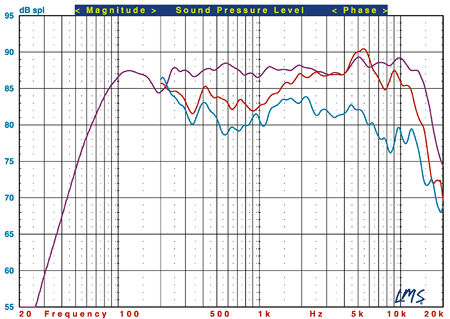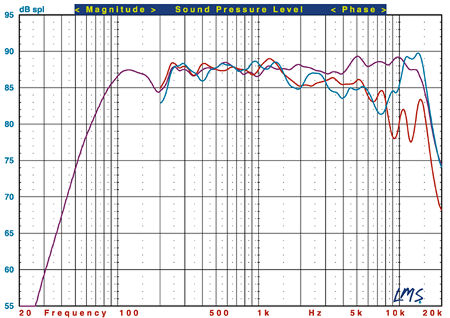Yamaha YSP-1 Digital Sound Projector Home Theater Speaker System Measurements
Because the YSP-1 is a self-powered design, its sensitivity and impedance characteristics are not relevant.
For the measurements shown, we fed the YSP-1 a source that produced only a center channel output. The pseudo-anechoic response—taken at a distance of 1 meter from the center of the front baffle, averaged over a 30° forward horizontal angle, and combined with the nearfield responses of the woofers—is shown in Fig.1 (violet). The useful bass extends down to approximately 57Hz (-10dB relative to the output at 115Hz). The on-axis average shown here is surprisingly flat for such a complex design; the main aberration is a slight rise in the response between 5kHz and 10kHz that averages roughly +1.5dB. The response remains essentially unchanged up to 15° off-axis (not shown). Moving further off-axis, the results start to look ragged. At 45°, the upper range becomes peaky. At 60°, the response becomes more uniform again, though it's not as flat as the on-axis average and its level is significantly lower.
Fig.2 again shows the YSP-1's averaged horizontal front response (violet), this time together with the vertical responses taken at +15° (red) and –15° (blue) relative to the front baffle midpoint. Both of these off-axis results are peaky, likely due to comb filtering between the multiple drivers. I recommend placing the front baffle as close as possible to the seated ear height—neither higher nor lower.
All of our off-axis measurements were likely strongly influenced by the intentional complexity of the phase and time relationships between the individual drivers—relationships that are not conducive to reliable standard measurements, but that were necessary to produce a single speaker that simulates the directional effects of a traditional array of individual speakers.—TJN

Fig.1: YSP-1, pseudo-anechoic horizontal response at 45° (red) and 60° (blue), measured opposite the midpoint of the front baffle.

Fig.2: YSP-1, pseudo-anechoic vertical response at +15° (red) and –15° (blue) relative to the midpoint of the front baffle.
Both: Violet: Pseudo-anechoic response measured opposite the midpoint of the front baffle, averaged across a 30° horizontal window and combined with the nearfield responses of the woofers.





























































